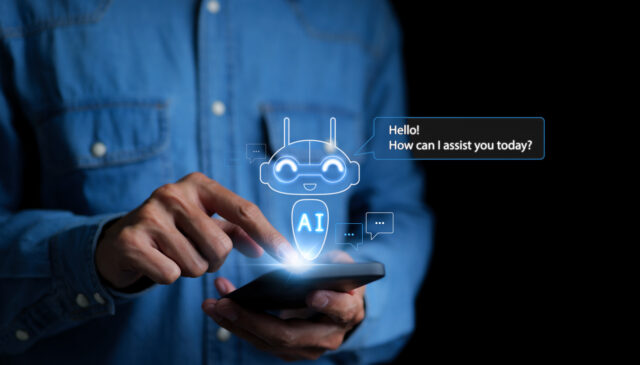2020 has been a year of tumultuous change and 2021 isn’t set to slow down. Technology has been the saving grace of the waves of turbulence this year, and next year as the use of technology continues to boom, we will see new systems and processes emerge and others join forces to make a bigger impact. From assistive technology to biometrics, ‘agritech’ and the rise in self-driving vehicles, tech acceleration will be here to stay, with COVID-19 seemingly just the catalyst for what’s to come. Of course, the increased use of technology will also bring its challenges, from cybersecurity and white-collar crime to the need to instil trust in not just those investing in the technology, but those using it, and artificial intelligence (AI) will be at the heart of this.

1. Instilling a longer-term vision
New AI and automation innovations have led to additional challenges such as big data requirements for the value of these new technologies to be effectively shown. For future technology to learn from the challenges already faced, a comprehensive technology backbone needs to be built and businesses need to take stock and begin rolling out priority technologies that can be continuously deployed and developed.
Furthermore, organisations must have a longer-term vision of implementation rather than the need for immediacy and short-term gains. Ultimately, these technologies aim to create more intelligence in the business to better serve their customers. As a result, new groups of business stakeholders will be created to implement change, including technologists, business strategists, product specialists and others to cohesively work through these challenges, but these groups will need to be carefully managed to ensure a consistent and coherent approach and long-term vision is achieved.
2. Overcoming the data challenge
AI and automation continue to be at the forefront of business strategy. The biggest challenge, however, is that automation is still in its infancy, in the form of bots, which have limited capabilities without being layered with AI and machine learning. For these to work cohesively, businesses need huge pools of data. AI can only begin to understand trends and nuances by having this data to begin with, which is a real challenge. Only some of the largest organisations with huge data sets have been able to reap the rewards, so other smaller businesses will need to watch closely and learn from the bigger players in order to overcome the data challenge.
3. Controlling compliance and governance
One of the critical challenges of increased AI adoption is technology governance. Businesses are acutely aware that these issues must be addressed but orchestrating such change can lead to huge costs, which can spiral out of control. For example, cloud governance should be high on the agenda; the cloud offers new architecture and platforms for business agility and innovation, but who has ownership once cloud infrastructures are implemented? What is added and what isn’t?
AI and automation can make a huge difference to compliance, data quality and security. The rules of the compliance game are always changing, and technology should enable companies not just to comply with ever-evolving regulatory requirements, but to leverage their data and analytics across the business to show breadth and depth of insight and knowledge of the workings of their business, inside and out.

In the past, companies struggled to get access and oversight over the right data across their business to comply with the vast quantities of MI needed for regulatory reporting. Now they are expected to not only collate the correct data but to be able to analyse it efficiently and effectively for regulatory reporting purposes and strategic business planning. There are no longer the time-honoured excuses of not having enough information, or data gaps from reliance on third parties, for example, so organisations need to ensure they are adhering to regulatory requirements in 2021.
4. Eliminating bias
AI governance is business-critical, not just for regulatory compliance and cybersecurity, but also in diversity and equity. There are fears that AI programming will lead to natural bias based on the type of programmer and the current datasets available and used. For example, most computer scientists are predominantly male and Caucasian, which can lead to conscious/unconscious bias, and datasets can be unrepresentative leading to discriminatory feedback loops.
Gender bias in AI programming has been a hot topic for some years and has come to the fore in 2020 again within wider conversations on diversity. By only having narrow representation within AI programmers, it will lead to their own bias being programmed into systems, which will have huge implications on how AI interprets data, not just now but far into the future. As a result, new roles will emerge to try and prevent these biases and build a more equitable future, alongside new regulations being driven by companies and specialist technology firms.
5. Balancing humans with AI
As AI and automation come into play, workforces fear employee levels will diminish, as roles become redundant. There is also inherent suspicion of AI among consumers and certain business sectors. But this fear is over-estimated, and, according to leading academics and business leaders, unfounded. While technology can take away specific jobs, it also creates them. In responding to change and uncertainty, technology can be a force for good and source of considerable opportunity, leading to, in the longer-term, more jobs for humans with specialist skillsets.
Automation is an example of helping people to do their jobs better, speeding up business processes and taking care of the time-intensive, repetitive tasks that could be completed far quicker by using technology. There remain just as many tasks within the workforce and the wider economy that cannot be automated, where a human being is required.
Businesses need to review and put initiatives in place to upskill and augment workforces. Reflecting this, a survey on the future of work found that 67% of businesses plan to invest in robotic process automation, 68% in machine learning, and 80% investing in perhaps more mainstream business process management software. There is clearly an appetite to invest strongly in this technology, so organisations must work hard to achieve harmony between humans and technology to make the investment successful.

6. Putting customers first
There is growing recognition of the difference AI can make in providing better service and creating more meaningful interactions with customers. Another recent report examining empathy in AI saw 68% of survey respondents declare they trust a human more than AI to approve bank loans. Furthermore, 69% felt they were more likely to tell the truth to a human than AI, yet 48% of those surveyed see the potential for improved customer service and interactions with the use of AI technologies.
2020 has taught us about uncertainty and risk as a catalyst for digital disruption, technological innovation and more human interactions with colleagues and clients, despite face-to-face interaction no longer being an option. 2021 will see continued development across businesses to address the changing world of work and the evolving needs of customers and stakeholders in fast-moving, transitional markets. The firms that look forward, think fast and embrace agility of both technology and strategy, anticipating further challenges and opportunities through better take-up of technology, will reap the benefits.











